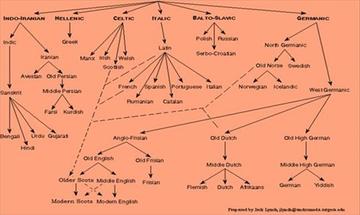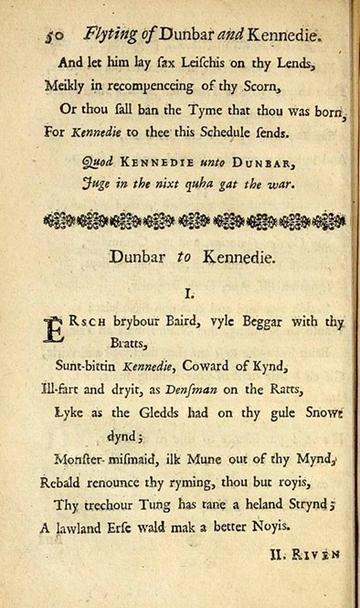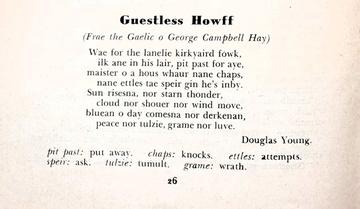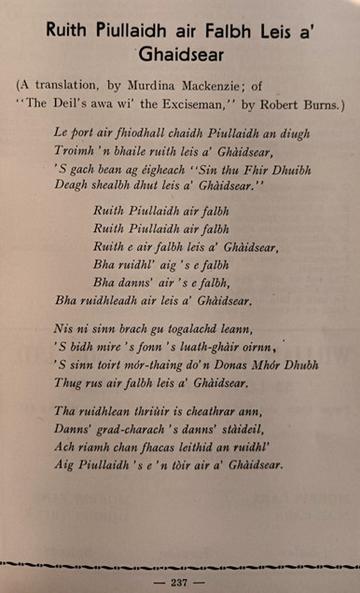Gaelic and Scots: Cultural Connections and Inspirations in the 20th Century
Languages in Ireland and Britain
In September 2024, a new CLARIN K-Centre based in the UK was certified called DR-LIB. K-Centres (or knowledge centres) are a key part of CLARIN’s infrastructure that help disseminate knowledge and resources to wider communities. DR-LIB focuses on Digital Resources for the Languages in Ireland and Britain. As part of these efforts, we are spotlighting events, initiatives, and projects supporting under-resourced languages in the UK and Ireland.
The following is a guest post from Dr Megan Bushnell with Dr Petra Johana Poncarová discussing the recent Forum for Research on the Languages of Scotland and Ulster (FRLSU) webinar on ‘Gaelic and Scots: Cultural Connections and Interpretations in the 20th century’, which was organised by Petra. Petra is a Marie Curie Fellow at the University of Glasgow, while Megan is a Researcher in Linguistic Data at the Oxford Text Archive. Both are active members of the FRLSU Committee. FRLSU – or Forum for Research on the Languages of Scotland and Ulster – is a triennial conference and network dedicated to the study and advocacy of the languages of Scotland and Ulster. These are predominantly Scots, Ulster Scots, and Gaelic, but ostensibly include any other language spoken, written, or signed within the area, including contemporary and modern varieties.
Scots and Gaelic share a long and complex relationship. Sometimes they are misunderstood as synonyms for one another, while in other contexts they are often perceived as having little in common. While both have been used in Scotland for centuries and have become markers of Scottish identity, they come from entirely separate linguistic families, with no linguistic continuum to exploit. Scots developed from the Northumbrian dialect of Old English and is closely related to English. Gaelic, on the other hand, is a Celtic language, closely related to Irish. Indeed, in the Middle Ages, these languages were referred to as ‘Inglis’ (or ‘English’) and ‘Ersch’ (or ‘Irish’), respectively, highlighting their linguistic genealogies.

Another factor is that the speakers of these languages have a history characterised at times by tension and misunderstanding. The division between the Scots-speaking Lowlanders and Gaelic-speaking Highlanders was a feature in Scottish culture even in the Middle Ages – so much so that poets played on it for laughs. In the Flyting of Dunbar and Kennedy – ‘flyting’ being a Scottish genre where poets trade excoriating insults (essentially the medieval version of a rap battle) – the poet Dunbar notes on numerous occasions that his rival Kennedy speaks ‘Erschry’ (l. 107) or is ‘Iersche’ (l. 49) in reference to his use of Gaelic, with the implication being that this is a blight on his poetic talent.

Nevertheless, these languages share more than just a national identity. Both have complicated relationships with English, whose increase in cultural currency contributed to Scots and Gaelic being downgraded in prestige - along with various other cultural and political forces that aimed to suppress other native languages within the British Isles. During the nineteenth century, the number of Gaelic speakers dropped dramatically, due to evictions, emigration, hostile policies, and prejudice. Meanwhile, Scots was steadily marked as nonstandard as Scotland transitioned from being an independent nation with its own monarchy and parliament, to a nation incorporated into a larger single political state. As a result, both languages have lost a lot of visibility and accessibility to those outside of Scotland, although the languages were present in diasporic communities, especially in Nova Scotia, Canada.
This is reflected in our own experiences with coming to learn about these languages: Megan as an American undergraduate only first learned about Scots as a visiting student at the University of St Andrews in 2011, but had no contact with Scottish Gaelic. Petra’s own experience was the reverse - having first wanted to learn Scots in 2009 in the Czech Republic, but finding the resources for learning Scots as a foreign language and outside Scotland very scarce, she switched to learning Scottish Gaelic instead. However, she never forgot Scots, and is always looking for connections between the two cultures and the two movements.
Starting in the twentieth century, there has been a movement to recover and celebrate uniquely Scottish language and literature and combat this erasure. This movement has often been described as a Scots-focused one, with a separate, parallel movement happening in Gaelic. However, there were and are many poets who worked with and moved between both languages, such as George Campbell Hay (1915–1984, Deòrsa Mac Iain Dheòrsa in Gaelic), Douglas Young (1913–1973), William Neill (1922-2010, Uilleam Nèill in Gaelic), and Derick Thomson (1921-2012, Ruaraidh MacThòmais in Gaelic).
In February 2025, Petra was invited to deliver the annual Association for Scottish Literature at the Scottish Parliament, and chose the connections between Gaelic and Scots in the 20th and 21st century as her topic, with special focus on the role of new users. To encourage more discussion on the topic, Petra teamed up with FRLSU to host an event to further explore the links between these two languages that have so often been underestimated and underexplored, and invited fellow researchers to deliver short talks on the poets listed above.
The event itself was a webinar, where five speakers were invited to speak for ten minutes on a specific literary figure or aspect of the cultural exchanges and links between Gaelic and Scots. The speakers included the following:
- Michel Byrne (University of Glasgow), a lecturer in Celtic & Gaelic and editor of the works of George Campbell Hay;
- Emma Dymock (University of Edinburgh), lecturer in Celtic and Scottish Studies, and editor of poems by Douglas Young;
- J. Derrick McClure (University of Aberdeen), eminent academic, linguistic activist, and translator of English and Gaelic into Scots;
- Ian Spring (Rymour Books), author and editor of William Neill’s works;
- and, of course, Petra herself, whose research focuses on the works of Derick Thomson, and who also translates Gaelic literature into Czech.
Throughout the presentations and discussions, several themes emerged. Perhaps the most evocative of these was the creative use of translation as a generative act, where the poets moved in and out of Gaelic, Scots, and English, using each language as an exploratory poetic tool. These poets would translate Gaelic poems into English and Scots, and vice versa. Perhaps most interesting was the practice of C. M. Grieve (Hugh MacDiarmid), who – according to J. Derrick McClure – translated Gaelic despite not knowing the language intimately, instead translating by proxy by having native speakers read and explain the poems to him. Indeed, it is this multilingual aspect of Scottish poetry that is one of the most evocative in my opinion, and what makes it so appealing to read.

Another compelling theme was how these poets embraced multilingualism, even while advocating for Scottish political and cultural independence. According to Emma Dymock, these poets saw language as a bridge builder, and were prepared to accept fluid boundaries when it came to language and literature, and promote both Gaelic and Scots in their dedication to Scottish independence. Indeed, numerous publications were showcased that featured representation of both Gaelic and Scots – such as the quarterly magazine Gairm, which published translations from Scots into Gaelic and reviews of Scots-related publications – as well as translations from other languages outside of Scotland, such as Italian in the works of George Campbell Hay.

The main takeaway from this webinar is that the relationship between Gaelic and Scots is very deep and creatively fruitful – despite being often characterised as immaterial or antagonistic. The literary figures showcased here demonstrate that linguistic boundaries – even between two very different languages – are not rigid, and that language can be a site of experimentation and cultural renewal. In a time when minority languages face significant challenges, revisiting the connections between Gaelic and Scots offers not just historical insight, but a hopeful model for how linguistic communities can collaborate and flourish together.
If you would like to see recordings of the webinar in question, you can access these through FRLSU’s YouTube channel at https://www.youtube.com/@FRLSU.
If you are interested in the work that FRLSU does and are interested in our next events, please check out our newly updated website at https://frlsu.org/ and get in touch!



